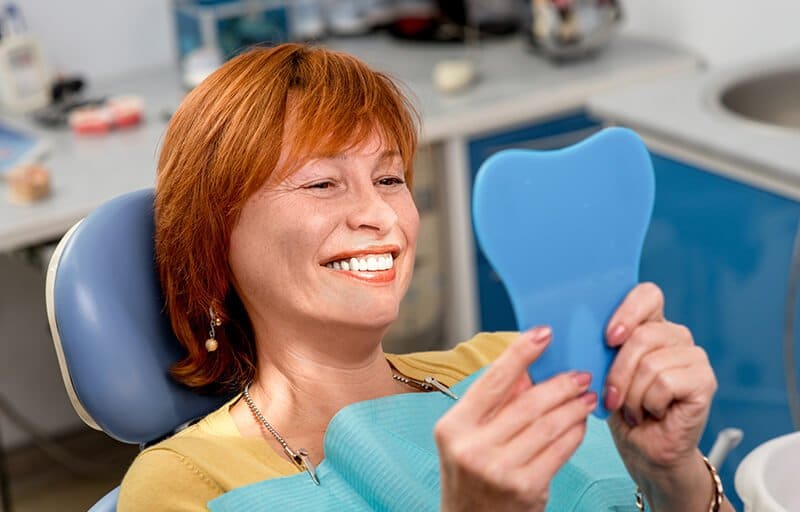A bright, dazzling smile shouldn’t be considered a vain luxury. White teeth will increase your self-confidence and willingness to smile. If you’re happy with your teeth, you’ll feel friendlier and more out-going – and that can have numerous benefits in your life.
Walk into any grocery or drug store and you’ll find countless over-the-counter tooth whitening remedies. But how safe and effective are they? If you want to whiten your teeth, should you use an at-home product or should you visit a dental professional?
At-Home Tooth Whitening Products
At-home whitening products are easy to find, relatively inexpensive to buy and require no trip to the dentist’s office. Here are some of the most common at-home whitening products:
- Whitening Toothpaste
- Pretty much every major brand of toothpaste has at least one type of whitening formula. The main benefit is ease of use. You simply brush your teeth as normal. Over time, the whitening agents in the paste will lighten your teeth by several shades.
- But “over time” is a key phrase here. Whitening toothpaste can take weeks or even month to show results. Plus, whitening toothpaste doesn’t actually change the color of your teeth. Instead, it removes external stains. In order to maintain white teeth, you’ll need to remove stain-causing foods and drinks from your diet.
- Whitening toothpaste can be effective if you have naturally white teeth which are slightly stained. Otherwise, you’ll probably want to use stronger whitening methods.
- Gel Strips
- These are clear, thin strips coated with a peroxide-based whitening gel. You apply these strips to the front surface of your upper and lower teeth. They usually need to stay attached for about 15 to 20 minutes.
- Generally, gel strips have inconsistent results. The strips don’t always stay attached properly. Plus, while you’ll see slight improvements after a few days, significant whitening takes about four months.
- Whitening Trays
- Similar in appearance to a mouth guard, these trays are filled with a peroxide-based bleaching agent. You wear the trays anywhere from 30 minutes to all night long, depending on the strength of the whitening gel. When wearing a tray, you shouldn’t eat or drink anything – even water.
- Trays come in different sizes but aren’t custom-made for your mouth. So the gel has a tendency to be unevenly applied, which results in white streaks on your teeth. Plus, non-custom trays can rub and irritate your gums.
In-Office Tooth Whitening Procedures
In-office whitening procedures are generally faster, safer and have longer lasting results. Here are the most common whitening methods found at the dentist’s office:
- Whitening Trays – The basic principle is the same as the at-home version. Trays are filled with a gel which you wear to whiten your teeth. However, in-office whitening trays have several advantages. Your dentist will be able to create custom trays which fit your mouth snugly and comfortably. Custom trays practically eliminate streaks and splotches. Instead, your smile will have an even white color. In-office procedures are supervised by your dentist. So he or she is able to give you a stronger bleaching solution. Typically, the in-office solution results in brighter teeth than what the at-home trays are able to achieve. Plus, the stronger solution works much faster.
- UV Lightening Procedures – Are trays a bit too slow for your liking? You can get whiter teeth in a day with in-office UV treatments. First, hydrogen peroxide whitening gel is applied to your teeth. Then a special UV lamp is used to light the area. When the UV light breaks down the gel, oxygen enters the enamel and dentin. This bleaches the tooth quickly without damaging the underlying structure.
Dental Diagnostics
Gels, trays and whitening toothpaste can only remove extrinsic stains, which are stains on the outer layer of the tooth. Discolored teeth can also have intrinsic stains, which are caused by an internal issue such as dental decay, certain medications or even genetics.
Only a dentist can properly identify and diagnose the cause of intrinsic tooth stains. He or she will be able to develop a specialized treatment plan. If at-home whitening treatments don’t seem to be working, you’ll want to schedule a dental appointment to check for any intrinsic causes.
What’s the Best Tooth Whitening Solution?
While at-home products often seem easier and cheaper, in-office treatments typically look better and last longer. Plus, professional dental monitoring goes a long way towards preventing any potential whitening-related problems.
At-home trays and strips don’t always create an even look. Plus, at-home treatments can result in temporary tooth and gum sensitivity. While this same sensitivity can occur with in-office treatments, your dentist will be able to minimize sensitivity by adjusting the concentration of whitening gel or applying desensitization pastes.
In-office treatments benefit from professional customization. Custom whitening trays are far more comfortable and effective than the ones you can buy in the store.
Many people are wary about in-office dental procedures because of the perceived costs. One effective way to reduce costs on cosmetic dental procedures is with a dental discount plan. This is a membership plan which provides discounts between 15% and 60% on a wide variety of procedures, including many tooth whitening procedures.
Dental discounts are applied right at the dentist’s office. Savings are available within about two or three days after purchasing a membership. There’s no need to be embarrassed by your smile. With a dental discount plan, in-office dental whitening procedures can be affordable today.


